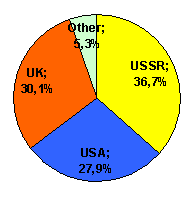Guys!!!
Important in order to keep this thread functioning and not to drown in off-topic.
I kindly ask you to keep your comments shot and straight to the point. No off-topic please. If you want to cretisice the numbers I give, You HAVE to propose your own with short, but reasonable explanation and sources. Remember that the scenario below is just one of the saveral and is not supposed to explain the Victory alone!
View #1:
In order to defeat Axis powers their forces had to be destroyed.
The forces consist of Ground force, Air force and Fleet.
The Axis powers are Germany including all of Europe but without Italy, Japan and Italy.
Since these country had invested different resources into the waging WW2 we split the importance of their destruction according to their war expences
(source: the book is at home right now. will be added later):
[INDENT]
[u]Importance of Destruction[/u]
Germany: 70%
Japan: 20%
Italy: 10%
Secondly, the importance of the destruction of sertain force type was diffent for different Axis powers. For example, the destruction of Japaneese Navy had much more severe implications for Japan, than destruction of German Navy for Germany. In this light I assigned the following weights:
[u]Importance of the Force type Destruction[/u]
Ground Air Fleet
Germany: 0,60 0,26 0,14
Japan: 0,20 0,30 0,50
Italy: 0,34 0,33 0,33
Finaly the share of each main Allied country in the destruction per Axis power and per force type.
This data means, that I estimate USA had destroyed 20% of Japanese ground forces, 50% of Japanese airforces and 70% of Japanese fleet. The numbers are my estimates:
[u]Share of Axis forces destroyed per Allied country [/u]
[u]Germany [/u]
USSR USA UK Other
Ground 0,70 0,20 0,05 0,05
Air 0,33 0,22 0,35 0,10
Fleet 0,05 0,20 0,70 0,05
[u]Japan [/u]
USSR USA UK Other
Ground 0,25 0,20 0,30 0,25
Air 0,05 0,50 0,30 0,15
Fleet 0,05 0,70 0,20 0,05
[u]Italy [/u]
USSR USA UK Other
Ground 0,30 0,30 0,30 0,10
Air 0,35 0,25 0,35 0,05
Fleet 0,05 0,35 0,55 0,05
[/INDENT]
These are my assumptions. Some are more grounded than the others.
Do you agree? Any corrections? Please comment.
After we roughly agree on these assumptions I will calculate the share of the input for each main Allied country into the Victory, for this scenario #1.
Update: The latest result of the discussion in this thread:
Comment:
UK in this exercise consist of Great Britain, Australia, New Zealand and Canada.
The “Other” part consist of all the Allied countries except USA, USSR and UK. F.ex. France, India, Greece, ect.
Remaining uncertainties:
[ul]
[li]the losses inflicted to Japanees in China
[/li][li]The distribution of Italian losses may need refinement
[/li][/ul]
[u]Importance of Destruction [/u]
Germany Italy Japan
70% 10% 20%
[u]Importance of the Force type Destruction [/u]
Ground Air Fleet
Germany 0,60 0,26 0,14
Japan 0,20 0,30 0,50
Italy 0,34 0,33 0,33
[u]Germany: share of forces destroyed per Allied country [/u]
USSR USA UK Other
Ground 0,70 0,20 0,05 0,05
Air 0,30 0,22 0,40 0,08
Fleet 0,05 0,20 0,70 0,05
[u]Italy: share of forces destroyed per Allied country [/u]
USSR USA UK Other
Ground 0,15 0,10 0,70 0,05
Air 0,05 0,25 0,68 0,02
Fleet 0,05 0,10 0,80 0,05
[u]Japan: share of forces destroyed per Allied country [/u]
USSR USA UK Other
Ground 0,09 0,35 0,45 0,11
Air 0,01 0,60 0,37 0,02
Fleet 0,01 0,70 0,26 0,03
[b][u]Final Result: the losses inflicted to the Axis powers [/u]
USSR USA UK Other
36,7% 27,9% 30,1% 5,3%
[/b]

